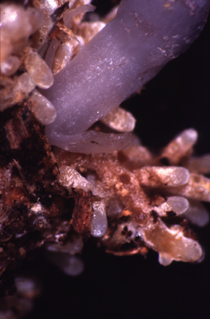菌异养

菌异营(英语:Myco-heterotrophy),或称真菌异养型,是植物与真菌的一种共生关系,此关系中植物不行光合作用,而是与真菌形成菌根后,透过寄生真菌取得全部或部分的有机养分。菌异营被认为是一种欺诈行为,行菌异营的植物靠真菌取得有机养分而得以在树林下方等缺乏光线的环境生存,这些植物有时被称为“菌根欺诈者”(mycorrhizal cheaters)[2]。
交互作用
[编辑]
绝对菌异营植物(obligate myco-heterotroph)因失去了叶绿素或整个光系统而完全失去了行光合作用的能力,只从寄生的真菌处获得有机养分,而兼性菌异营植物(facultative myco-heterotrophy)本身仍有行光合作用的能力,但从寄生的真菌处获得额外的养分来源[2]。有些兰科的植物在生活史的某一阶段是绝对菌异营者,没有行光合作用的能力,其他阶段则转为兼性菌异营者或失去菌异营的行为[3]。不过并非所有不行光合作用的植物都行菌异营,菟丝子等植物没有叶绿体,透过直接寄生其他植物取得养分,即非菌异营者[4]。
过去人们误认为这些不行光合作用的植物是像真菌一样,直接分解环境中的有机物质以取得养分,而将它们称为腐生植物,现在知道这些植物并没有直接分解有机物质的能力,只能透过菌异营或直接寄生其他植物等寄生的方式取得养分[5][6]。
菌异营中,植物与真菌交互作用的部位为植物的根与真菌的菌丝体,与菌根相仿,也被认为是由菌根演化而来的一种交互作用[5]。在菌根中,真菌帮助植物吸收水分与无机盐,而有机物流动的方向是从植物流向真菌,但在菌异营中流向相反,是由真菌流向植物[7][8],因此菌异营的植物算是一种外寄生物(epiparasites)[5][6][9]。且由于许多菌根在底下都会透过菌丝相连,形成称为菌根网的复杂结构[10],使植物用以和其他植物交换物质[6],许多菌异营中被寄生的真菌也是从其他植物的菌根中取得有机养分的,在这个系统中,菌异营的植物是一个欺诈者,从系统中获取有机养分,却没有提供相应回报[5]。
也有些菌异营的植物寄生于分解环境中有机物为生的腐生真菌[11]。另外也有研究显示有些演化上与菌异营植物亲缘接近,但本身能正常行光合作用的绿色植物也是兼性菌异营者,即它们以光合作用取得有机养分之外,还能从真菌处获取额外养分[12][13]。
在寄生真菌之馀,菌异营的植物可能有刺激真菌生长的机制,有研究显示须腹菌属真菌可以同时与菌异营的血晶兰以及非菌异营的红果冷杉形成菌根,此共生关系中,血晶兰可以刺激真菌与红果冷杉的生长,不过具体机制亦不明[14]。
物种
[编辑]许多植物都演化出了菌异营的交互作用,水晶兰亚科、不行光合作用的兰科植物、甚至属于苔藓植物的腐生苔属和属于裸子植物的寄生松属均是菌异营者[2],兰科植物与真菌形成的兰菌根便是菌异营的经典例子,是兰科植物种子萌发与生长不可或缺的构造[15]。兼性菌异营在龙胆科植物中相当常见,也有部分属如Voyria是绝对菌异营者。另外有些蕨类与石松的配子体世代也行菌异营[3][6][16]。而被寄生的真菌通常是可以形成菌根,而有很大的能量潜力可以吸取的种类,不过也有研究显示有菌异营植物可以寄生腐生真菌,甚至菌丝体网络复杂的植物病原菌蜜环菌[6]。形成菌异营的菌根属于外菌根、丛枝菌根与兰菌根者皆有[17],行菌异营的植物与真菌相当多样,且在分类上分属不同类群,表示菌异营是从菌根多次平行演化而出现的交互作用[17]。
演化
[编辑]菌异营可能是由互利共生的菌根演化而来,许多例子中,菌异营的演化过程可能是植物细胞外的外菌根穿透植物细胞形成内菌根,有机物的流向再经由不明机制逆转所致[2]。部分菌异营植物可能是由原本就生存在树林下方、缺乏光线的环境的绿色植物演化而来[2]。而由于许多在菌异营植物中,真菌对种子萌发的阶段相当重要,有假说认为菌异营在演化早期可能是真菌在植物种子萌发时先提供其有机养分作为投资,待植物长成可以行光合作用后再取得有机养分作为回报,而形成互利共生的作用模式,之后有些植物渐演化出长成后避免向真菌输入有机养分的机制,即成为绝对菌异营植物[2]。
参考资料
[编辑]- ^ Yang, S; DH Pfister. Monotropa uniflora plants of eastern Massachusetts form mycorrhizae with a diversity of russulacean fungi. Mycologia. 2006, 98 (4): 535–540 [2018-08-14]. PMID 17139846. doi:10.3852/mycologia.98.4.535. (原始内容存档于2009-07-19).
- ^ 2.0 2.1 2.2 2.3 2.4 2.5 Martin I. Bidartondo. The evolutionary ecology of myco-heterotrophy 167 (2). New Phytologist: 335-352. 2005. doi:10.1111/j.1469-8137.2005.01429.x.
- ^ 3.0 3.1 Leake JR. The biology of myco-heterotrophic ('saprophytic') plants. 127. New Phytologist: 171–216. 1994. doi:10.1111/j.1469-8137.1994.tb04272.x.
- ^ Dawson JH, Musselman LJ, Wolswinkel P, Dörr I. Biology and control of Cuscuta 6. Reviews of Weed Science: 265–317. 1994.
- ^ 5.0 5.1 5.2 5.3 Bidartondo, Martin I. The evolutionary ecology of myco-heterotrophy. New Phytologist. 2005-04-12, 167 (2): 335–352. ISSN 0028-646X. doi:10.1111/j.1469-8137.2005.01429.x.
- ^ 6.0 6.1 6.2 6.3 6.4 Plants parasitic on fungi: unearthing the fungi in myco-heterotrophs and debunking the ‘saprophytic’ plant myth. Mycologist. 2005-08-01, 19 (3): 113–122. ISSN 0269-915X. doi:10.1017/S0269-915X(05)00304-6.
- ^ Trudell SA, Rygiewicz PT, Edmonds RL. Nitrogen and carbon stable isotope abundances support the myco-heterotrophic nature and host-specificity of certain achlorophyllous plants 160. New Phytologist: 391–401. 2003. doi:10.1046/j.1469-8137.2003.00876.x.
- ^ Bidartondo MI, Burghardt B, Gebauer G, Bruns TD, Read DJ. Changing partners in the dark: isotopic and molecular evidence of ectomycorrhizal liaisons between forest orchids and trees 271. Proceedings of the Royal Society of London, series B: 1799–1806. 2004. doi:10.1098/rspb.2004.2807.
- ^ Selosse M-A, Weiss M, Jany J, Tilier A. Communities and populations of sebacinoid basidiomycetes associated with the achlorophyllous orchid Neottia nidus-avis (L.) L.C.M. Rich. and neighbouring tree ectomycorrhizae 11. Molecular Ecology: 1831–1844. 2002. doi:10.1046/j.1365-294X.2002.01553.x.
- ^ Peter Kennedy. Common Mycorrhizal Networks: An Important Ecological Phenomenon. MykoWeb (originally published on Mycena News). November 2005 [2012-01-19]. (原始内容存档于2012-02-04).
- ^ Martos F, Dulormne M, Pailler T, Bonfante P, Faccio A, Fournel J, Dubois M-P, Selosse M-A. Independent recruitment of saprotrophic fungi as mycorrhizal partners by tropical achlorophyllous orchids 184. New Phytologist: 668–681. 2009. doi:10.1111/j.1469-8137.2009.02987.x.
- ^ Gebauer G, Meyer M. 15N and 13C natural abundance of autotrophic and myco-heterotrophic orchids provides insights into nitrogen and carbon gain from fungal association 160. New Phytologist: 209–223. 2003. doi:10.1046/j.1469-8137.2003.00872.x.
- ^ Selosse M-A, Roy M. Green plants eating fungi: facts and questions about mixotrophy 14. Trends in Plant Sciences: 64–70. 2009. PMID 19162524. doi:10.1016/j.tplants.2008.11.004.
- ^ Bidartondo MI, Kretzer AM, Pine EM, Bruns TD. High root concentration and uneven ectomycorrhizal diversity near Sarcodes sanguinea (Ericaceae): a cheater that stimulates its victims? 87 (12). American Journal of Botany: 1783-1788. 2000. doi:10.2307/2656829.。
- ^ Smith, S. E.; Read, D. J.; Harley, J. L. Mycorrhizal symbiosis 2nd. San Diego, Calif.: Academic Press. 1997. ISBN 0126528403. OCLC 35637899.
- ^ Taylor DL, Bruns TD, Leake JR, Read DJ. Mycorrhizal specificity and function in myco-heterotrophic plants. Sanders IR, van der Heijden M (编). Ecological Studies (PDF). Mycorrhizal Ecology 157 (Springer-Verlag). 2002: 375–414 [2018-08-14]. ISBN 3-540-00204-9. (原始内容 (PDF)存档于2017-05-31).
- ^ 17.0 17.1 Imhof S. Arbuscular, ecto-related, orchid mycorrhizas—three independent structural lineages towards mycoheterotrophy: implications for classification? 19 (6). Mycorrhiza: 357–363. 2009 [2018-08-18]. (原始内容存档于2018-08-18).


